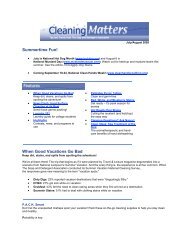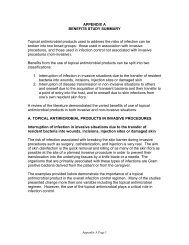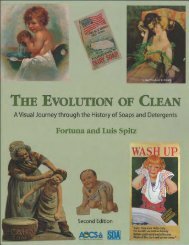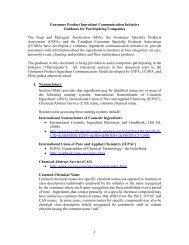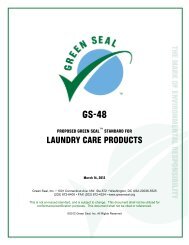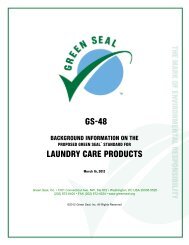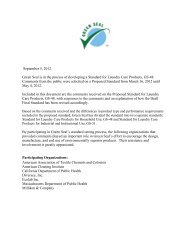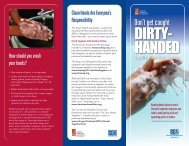subchapter c -- federal hazardous substances act regulations
subchapter c -- federal hazardous substances act regulations
subchapter c -- federal hazardous substances act regulations
Create successful ePaper yourself
Turn your PDF publications into a flip-book with our unique Google optimized e-Paper software.
containers intended for sale as art materials to<br />
users.<br />
(9) Sensitizer — a substance known to<br />
cause, through an allergic process, a chronic<br />
adverse health effect which becomes evident<br />
in a significant number of people on reexposure<br />
to the same substance.<br />
(10) Toxic — applies to any substance<br />
that is likely to produce personal injury or<br />
illness to humans through ingestion,<br />
inhalation, or skin cont<strong>act</strong>.<br />
(11) Toxicologist — an individual who<br />
through education, training, and experience<br />
has expertise in the field of toxicology, as it<br />
relates to human exposure, and is either a<br />
toxicologist or physician certified by a<br />
nationally recognized certification board.<br />
(12) Bioavailability — the extent that a<br />
substance can be absorbed in a biologically<br />
<strong>act</strong>ive form.<br />
(C) Requirements. (1) The producer or<br />
repackager of art materials shall submit art<br />
material product formulation( s) or<br />
reformulation(s) to a toxicologist for review,<br />
such review to be in accordance with<br />
paragraph (b)(8)(l)(D) of this section. The<br />
toxicologist shall be required to keep product<br />
formulation(s) confidential.<br />
(2) Unless otherwise agreed in writing by<br />
the producer or repackager, no one other than<br />
the toxicologists shall have access to the<br />
formulation(s); except that the toxicologists<br />
shall furnish a patient’s physician, on a<br />
confidential basis, the information necessary to<br />
diagnose or treat cases of exposure or<br />
accidental ingestion.<br />
(3) The producer or repackager, upon<br />
advice given by a toxicologist in accordance<br />
with paragraph (b)(8)(i)(D) of this section and<br />
based upon generally accepted, wellestablished<br />
evidence that a component<br />
substance(s) is known to cause chronic adverse<br />
health effects adopt precautionary labeling in<br />
accordance with paragraph (b)(8)(i)(E) of this<br />
section.<br />
(4) Labeling shall conform to any labeling<br />
pr<strong>act</strong>ices prescribed by <strong>federal</strong> and state<br />
statutes or <strong>regulations</strong> and shall not diminish<br />
the effect of required acute toxicity warnings.<br />
(5) The producer or repackager shall<br />
supply a poison exposure management<br />
information source the generic formulation<br />
information required for dissemination to<br />
poison control centers or shall provide a 24-<br />
16 CFR Ch. II (1–1–05 Edition)—proposed modificication – 6/25/06<br />
-- 17 --<br />
hour cost-free telephone number to poison<br />
control centers.<br />
(6) The producer or repackager shall have<br />
a toxicologist review as necessary, but at least<br />
every 5 years, art material product<br />
formulation(s) and associated label(s) based<br />
upon the then current, generally accepted,<br />
well-established scientific knowledge.<br />
(7) Statement of Conformance —<br />
“Conforms to ASTM Pr<strong>act</strong>ice D-4236,” or<br />
“Conforms to ASTM D-4236,” or “Conforms<br />
to the health requirements of ASTM D-4236.”<br />
This statement may be combined with other<br />
conformance statements. The conformance<br />
statement should appear whenever pr<strong>act</strong>ical on<br />
the product; however, it shall also be<br />
acceptable to place the statement on one or<br />
more of the following:<br />
(i) The individual product package,<br />
(ii) a display or sign at the point of<br />
purchase,<br />
(iii) separate explanatory literature available<br />
on requirements at the point of purchase,<br />
(iv) a response to a formal request for bid or<br />
proposal.<br />
(D) Determination of Labeling. (1) An art<br />
material is considered to have the potential for<br />
producing chronic adverse health effects if any<br />
customary or reasonably foreseeable use can<br />
result in a chronic hazard.<br />
(2) In making the determination, a<br />
toxicologist(s) shall take into account the<br />
following:<br />
(i) Current chemical composition of the art<br />
material, supplied by an analytical laboratory<br />
or by an industrial chemist on behalf of a<br />
manuf<strong>act</strong>urer or repackager.<br />
(ii) Current generally accepted, well<br />
established scientific knowledge of the chronic<br />
toxic potential of each component and the total<br />
formulation.<br />
(iii) Specific physical and chemical form of<br />
the art material product, bioavailability,<br />
concentration, and the amount of each<br />
potentially chronic toxic component found in<br />
the formulation.<br />
(iv) Reasonably foreseeable uses of the art<br />
material product as determined by consultation<br />
with users and other individuals who are<br />
experienced in use of the material(s), such as<br />
teachers, or by market studies, unless such use<br />
information has previously been determined<br />
with respect to the specific art material(s)<br />
under review.



